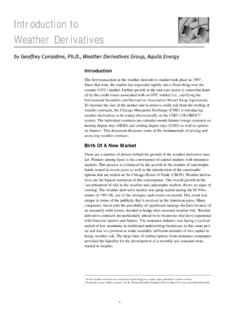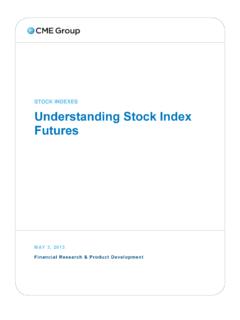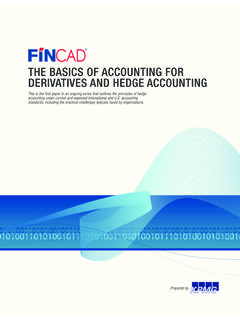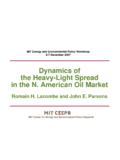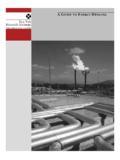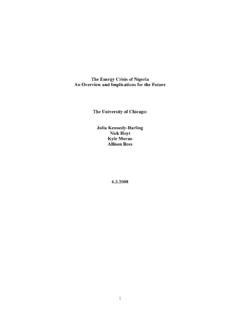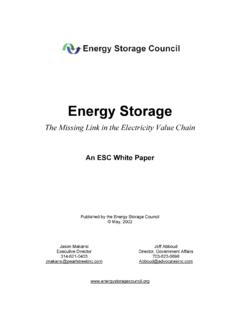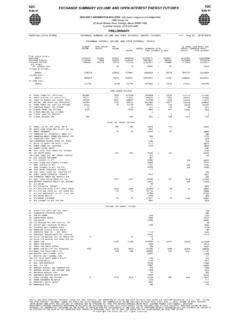Transcription of Energy Price Spread: Natural Gas vs. Crude Oil in …
1 11234 Energy Price Spread: Natural Gas vs. Crude Oil in the USnsightsMarketThe Energy production boom in the United States over the last seven years has led to a very interesting and dynamic relationship between Natural gas and Crude oil. From the vantage point of units of Energy , the Price spread between Natural gas and Crude oil is significant, with Natural gas giving a lot more Energy bang per buck compared to oil. In BTU terms, $1 of Natural gas can obtain 200,000 units of Energy (at a spot rate of $5/million BTU) compared to $1 of WTI oil which garners 60,000 units of Energy (at a spot rate of $97/barrel).
2 This is a whopping 330% Energy content Price gap even after the polar vortex and deep freeze have raised Natural gas prices. This massive Energy Price gap raises questions about how long it may persist, and our read of the market consensus appears to measure the time required to narrow the gap in decades, while our own base case scenario is that it could happen in just three to five years. Our objective in this report is to frame the issues that may decide the future of the Energy Price gap between US Natural gas and Crude oil. Round I: Shale enters the RingA brief historical perspective is useful. In tandem with large discoveries of shale-related Natural gas, new technologies (fracking and horizontal drilling) have allowed shale-related Natural gas production to increase by a tremendous 417% between 2007 and 2012.
3 This surge made up a large portion of the overall increase in Natural gas production, which expanded by over 20% in that same period. With a much larger supply, Natural gas prices fell by over 50% from 2006 into 2013. Natural gas prices averaged just over $7/million BTU during the 2003-2008 period, with the average Price dropping to below $4/million BTU during 2010-2013. Regardless, Natural gas like many commodities has been susceptible to Price spikes with a high in the period of $13/million BTU reached in 2005 and a sustained period of $10/million BTU occurring in 2008. Indeed, Natural gas prices have tended to display even more volatility historically than Crude oil prices.
4 And recently, the extreme deep freeze and stormy weather experienced in the Midwest, Eastern and Southern parts of the US in the winter of 2013/2014 has resulted in increased demand pushing Henry Hub Natural Gas spot prices above $5/million BTU, at least temporarily, although still lower than the average Price in 2002-2006 before the production boom. Crude oil supply has also increased within the US, by 23% since 2007. Yet, WTI Crude oil prices have risen from approximately $72/barrel in 2007 to $98/barrel in December of 2013. While not as volatile as Natural gas, there have been some temporary periods of high prices, and no one should forget Crude s staggering high of $145/barrel in June of 2008, preceded by prices maintained above $120/barrel in May of 2008.
5 Looking through the Price spikes, on average Crude oil prices are some one-third higher now than in the years preceding the expanded FEBRUARY 6, 2014BY SAMANTHA AZZARELLO, ECONOMIST, CME GROUPJANUARY 21, 201421234 production in the US, with a trading range over the last 12 months of $92-$106 per barrel, displaying a tendency toward reduced volatility. With both Crude oil and Natural gas production rising in the US, and despite some temporary Price spikes, average Natural gas prices are lower and Crude oil prices higher than before the production revolution began. As noted already, this differential Price behavior has resulted in the wide Energy Price gap, whereby Natural gas provides three times the BTUs per dollar that Crude oil does.
6 As potential substitutes in some cases, and as future substitutes as technology and uses evolve, the unusual Price spread patterns between the two sources of Energy are likely to result in a dynamic relationship which could play out in the US Energy markets over the next 5 to 10 is, such a significant Energy cost gap would logically set in motion market forces leading to a shift in usage patterns having the potential to close the spread over time. Decisions to invest and develop new or expanded uses for Natural gas depend in part on whether or for how long one expects Natural gas to remain the less expensive source of Energy .
7 We would note that direct competition is not a necessary condition for the Price spread to close. Before 2005, a BTU Price gap did not exist, and there was little direct competition between Crude oil and Natural gas as sources of Energy . Our perspective, however, is that structural change in the Natural gas market is re-setting conditions in a way such that the Energy Price spread between Natural gas and Crude oil may close faster than expected. When two Energy sources have only limited direct competition, closing the Energy Price gap may take decades. If Natural gas and Crude oil come more directly into competition with each other as sources of Energy for end-users, then the Energy Price gap might be closed in a matter of II: Shifting Usage PatternsCrude oil is an Energy source mainly used by only one sector.
8 According to the US Energy Information Administration (EIA), 71% of total Crude usage in the US is related to transportation, while industrial sector uses account for approximately 20%, and power generation and commercial use is negligible. Natural gas, contrastingly, is a much more diversified Energy source in terms of use. Usage is currently split amongst the power generation, industrial, and residential/commercial end-use sectors at approximately 30% each. For our analysis, however, the sector of most interest is transportation, where Natural gas usage is only a modest 3%, but growing quickly. From 2007 to 2012, Natural gas consumption in the US transportation sector increased by 22%.
9 This report will discuss the potential interplay between Natural gas and Crude oil in each of the principal end-use sectors in turn, starting with where there is indirect competition (residential/commercial use and power generation), followed by some direct competition (industrial) and finally focusing on the transportation sector where there is the most potential for a direct, head on battle between the two Energy sources that could profoundly influence relative Price dynamics in future years in the generation, while once heavily reliant on coal, has shifted markedly into Natural gas in recent years.
10 Natural gas usage for electric power generation increased by 33% from 2007 to 2013. This pushed more coal into exports rather than for domestic consumption. Oil has never been a viable alternative fuel for power generation, so a movement to using increased Natural gas in power generation does not provide any direct competition between oil and gas, although the potential for cheaper electric prices could modestly impact oil usage in the industrial sector over time. Furthermore, increased use of Natural gas in electricity generation is being offset somewhat by the construction of new, modern plants, which are highly efficient and use less gas.
